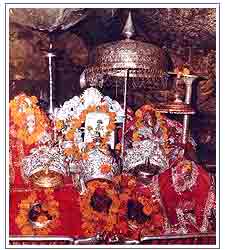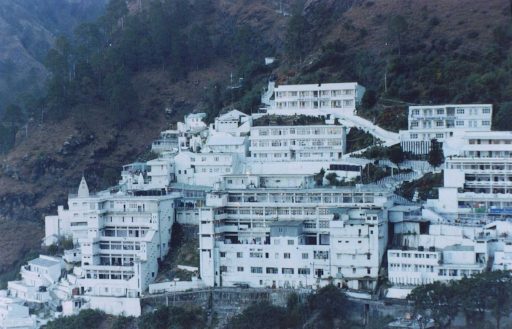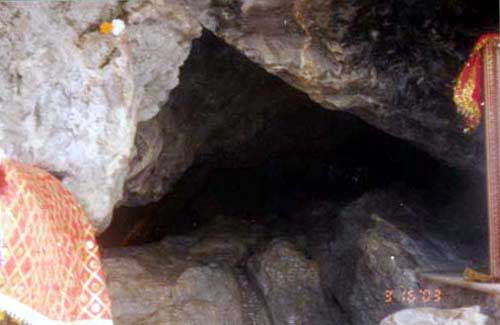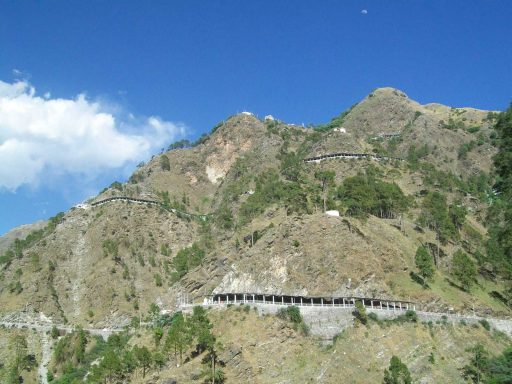Shri Mata Vaishno Devi Shrine is one of the most religious & oldest Hindu pilgrimage destination in India located in the state of Jammu & Kashmir. The Holy Cave of the Mother is situated at an altitude of 5200 feet on the holy “Trikuta Hills” of the Shivalik Hill Range. The Yatris have to undertake a trek of nearly 12 km from the base camp at Katra. The Town Katra is 50 Kms away from Jammu and 35 Kms from District HQ Udhampur and is linked by road. The Mata Vaishno Devi Shrine is one 24 hrs Customer Support of the most popular Shrines of India. This abode of Goddess Durga is supposed to be one of the wish fulfilling places, where millions of devotees from India and abroad gather for the blessings of Maa Vaishno Devi.

Maa Vaishno Devi – Pindis
At the culmination of their pilgrimage, the yatries are blessed with the Darshans of the Mother Goddess inside the Holy Cave. The Maa Vaishno Devi’s abode is in 100 feet long cave with a narrow opening. The holy cold and crystal clear water washes the lotus feet of the Mata’s “Pindian”. There are no statues or idols inside the Cave*, but there are three natural pindies representing Maa Maha Sarswati, Maa Maha Lakshmi, Maa Maha Kali, which represent creative, Preservative, and Destructive aspects of the Super Power “Adi Shakti”. It is an ancient shrine whose reference is found in the Vedas and ancient scriptures.
It is believed that the Darshans of 33 crore (330 million) Gods and Goddesses are present in the Holy Cave. It is believed that at some given point of time, each of the 330 million gods and goddesses have worshipped the Mother Goddess in the Holy Cave and have left their symbolical marks inside. It is also believed that during Poojan and Aarti in the morning and evening, all these Gods and Goddesses arrive at the Holy Cave to pay their obeisance to the Mother.
At the entry of the Holy Cave, towards the left hand side, is the symbol of Vakra Tund Ganesh. Adjacent to the symbol of Lord Ganesh are the symbols of Surya and Chandra Dev. Once inside the Holy Cave, one crosses over the Dadh (torso) of Bhairon Nath, which is around 14 feet long. Due to the impact of the mighty blow of the Divine Mother, while the head of Bhairon Nath fell atop an adjacent mountain a couple of kilometers away from the Holy Cave, his body lay lifeless at the entrance of the Holy Cave.
After the Dadh (torso) of Bhairon is the symbol of Lord Hanuman known as Launkra Beer. Thereafter one comes across Charan Ganga, the legendary river flowing from the feet of Mata. Those having Darhans through the old Cave have to wade through water beyond this point. Around 23 feet beyond Launkra Beer, on the left upper hand side, the roof of the cave flares out and the entire weight of this cave appears to rest on the innumerable heads of Shesh Nag. Immediately below Shesh Nag is the Havan Kund of Mata and adjacent to it are the symbols of Shankh, Chakra, Gada and Padam.
Above, almost touching the ceiling of the cave are the symbols of five Pandavs, Sapt rishis, Than (udders or breast) of the divine cow Kamdhenu, symbols of Brahma-Vishnu-Mahesh and Shiv-Parvati. 3 feet further ahead, on an elevation can be seen the Khamba that was gripped by the legendary worshipper Prahlad. Diagonally below this, at the water level is the Yantra with innumerable mystical signs and symbols inscribed on it. 22 feet beyond this point is located the Sher Ka Panja, symbolizing the lion which is the mount of the Mata Vaishno Devi Ji. The distance from the entry point to the Sher Ka Panja is 59 feet. 13 feet beyond this, immediately above the head of the worshipper, is located the symbol of the Primary Hood of Shesh Nag which appears to be bearing the weight of the roof of the Cave at this point. 6 feet further ahead, on the left hand side, are the symbols of Shankar and Gauri.

Maa Vaisno Devi Yatra – Bhawan
13 feet beyond this are the Holy Pindies of Mata Maha Kali, Mata Maha Lakshmi Vaishno Devi and Mata Maha Saraswati. To the right of the Holy Pindies on the upper side can be seen the symbols of Lord Ganesh, Surya Dev, Chandra Dev and Goddess Annapurna. Slightly behind the Holy Pindies, on the right hand side can be seen the symbol of the seated Sinh Raj (Lion). A little ahead of it is the full hand of the Mother Goddess, raised in the Varad Hast mode, granting boons to the world. An interesting corollary to the Varad Hast of Mata lies in the story of the sacrifice of Sati. The Scriptures say that the hand of Mother Sati fell in the region of Kashmir creating a Shaktipeeth. There are a few sources, however, which believe that it was at this place i.e. the Holy Cave at Trikuta Mountain that the hand of Sati fell and the Varad Hast in the Holy Cave provides some link to the tale of Sati as given below in detail. Immediately opposite the Holy Pindies is the natural symbol of Lord Pashupati Nath.

Shri Mata Vaishno Holy Shrine Cave
Yatris may however note that most of these Darshans are possible only if the original cave is used. However, owing to the heavy rush, usually the new tunnels are used and the original cave is opened only during the lean seasons. Yatries desirous of having all the Darshans are advised to formulate their programme to correspond with the lean seasons.
After this can be seen the symbol of Lord Hanuman called Launkra. Water gushes out of the base of the holy Pindies and flows out of the holy Cave. This gush of Holy water is known as Charan Ganga and the water of this stream is collected in small containers by the devotees and taken home. The same water is also channelised to the bathing ghat and the devotees take a bath in this water before they join the queue for Darshan of the holy Pindies. Darshans are open round the clock throughout the year.
Like with most old Shrines, it is not possible to ascertain when exactly the pilgrimage to the Holy Shrine started. A geological study of the Holy Cave has indicated its age to be nearly a million years. Vedic literature gives no reference to the worship of any female deity, although the mountain Trikuta does find its mention in Rigveda, the oldest of the four Vedas The practice of worshipping Shakti, largely started in the Puranic period.
The first mention of the Mother Goddess is in the epic Mahabharat. When the armies of Pandavs and Kaurvas were arrayed in the battlefield of Kurukshetra, Arjun, the chief warrior of Pandavs upon advice of Sri Krishna; meditated upon the Mother Goddess and sought Her blessings for victory. This is when Arjun addresses the Mother Goddess as ‘Jambookatak Chityaishu Nityam Sannihitalaye’, which means ‘you who always dwell in the temple on the slope of the mountain in Jamboo’ (probably referring to the present day Jammu).
It is also generally believed that the Pandavs were the first to build the temples at Kol Kandoli and Bhawan in reverence and gratitude for the Mother Goddess. On a mountain, just adjacent to the Trikuta Mountain and overlooking the Holy Cave are five stone structures, which are believed to be the rock symbols of the five Pandavs.
Perhaps the oldest reference of the visit of a historical figure to the Holy Cave is that of Guru Gobind Singh who is said to have gone there via Purmandal. The old foot track to the Holy Cave passed through this well-known pilgrimage centre.
Some traditions believe this Shrine to be the holiest of all Shaktipeeths (a place where the Mother Goddess, the Eternal Energy has Her abode) since the skull of Mata Sati fell here. Others believe that her right arm had fallen here. But some scriptures do not agree with it. They do agree that at a place called Gandarbal in Kashmir, the right arm of Sati had fallen. Nevertheless, in the Holy Cave of Shri Mata Vaishno Deviji, one does find stone remains of a human hand, popularly known as Varad Hast (the hand that grants boons and blessings). Besides this is recognized as one of the Shakti Peethas.

Maa Vaisno Devi Dhaam Yatra
Since the year 1986, when the Shri Mata Vaishno Devi Shrine Board (commonly called Shrine Board) was formed, the management of the Shrine and regulation of the Yatra has been vested in the Board. The Board has undertaken a number of developmental activities aimed at making the Yatra a comfortable and satisfying experience for the Yatris. The Board continues to reinvest the offerings and donations received in carrying out improvements in various kinds of Yatri facilities.
* Please Note:- This site is just an informational site, for full details about Yatara to Maa Vaisnho Devi Dhaam Please Visit : MaaVaishnoDevi.org
* Please Note:- It is reiterated that Darshans inside the Holy Cave are in the form of natural rock formations called Pindies. There are no statues, pictures or idols inside. All along the track and at the Bhawan, there are many photographs explaining the nature of Darshans inside the Holy Cave. Yatries should observe these carefully since these are meant to guide them towards the final Darshans in the Holy Cave.